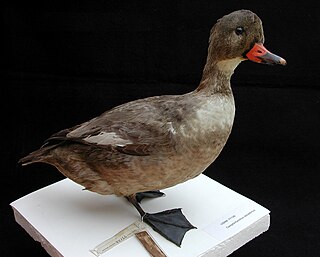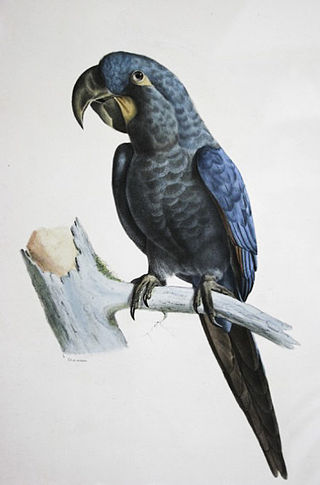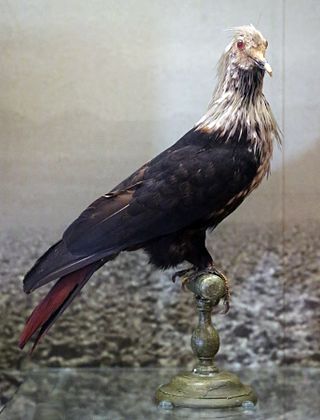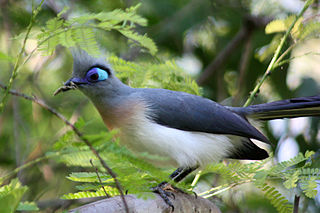
The dodo is an extinct flightless bird that was endemic to the island of Mauritius, which is east of Madagascar in the Indian Ocean. The dodo's closest genetic relative was the also-extinct Rodrigues solitaire. The two formed the subfamily Raphinae, a clade of extinct flightless birds that were a part of the family which includes pigeons and doves. The closest living relative of the dodo is the Nicobar pigeon. A white dodo was once thought to have existed on the nearby island of Réunion, but it is now believed that this assumption was merely confusion based on the also-extinct Réunion ibis and paintings of white dodos.

The Labrador duck was a North American bird; it has the distinction of being the first known endemic North American bird species to become extinct after the Columbian Exchange, with the last known sighting occurring in 1878 in Elmira, New York. It was already a rare duck before European settlers arrived, and as a result of its rarity, information on the Labrador duck is not abundant, although some, such as its habitat, characteristics, dietary habits and reasons behind its extinction, are known. There are 55 specimens of the Labrador duck preserved in museum collections worldwide.

A hopping mouse is any of about ten different Australian native mice in the genus Notomys. They are rodents, not marsupials, and their ancestors are thought to have arrived from Asia about 5 million years ago.

The spectacled cormorant or Pallas's cormorant is an extinct marine bird of the cormorant family of seabirds that inhabited Bering Island and possibly other places in the Komandorski Islands and the nearby coast of Kamchatka in the far northeast of Russia. The modern distribution was shown to be a relic of a wider prehistoric distribution in 2018 when fossils of the species from 120,000 years ago were found in Japan. It is the largest species of cormorant known to have existed.

The Toamasina Province is a former province of Madagascar with an area of 71,911 km². It had a population of 2,855,600 (2004). Its capital was Toamasina, the most important seaport of the country. The province was also known as Tamatave Province.

The glaucous macaw is a critically endangered or possibly extinct species of large, blue and grey South American parrot, a member of a large group of neotropical parrots known as macaws. This macaw is closely related to Lear's macaw and the hyacinth macaw. In Guaraní, it is called guaa-obi after its vocalizations.

Nosy Boraha[ˈnuʃ buˈrahə̥], previously known as Sainte-Marie, main town Ambodifotatra, is an island off the east coast of Madagascar. The island forms an administrative district within Analanjirofo Region, and covers an area of 222 km2. It has a population estimated at 30,000.

The Cuban macaw or Cuban red macaw is an extinct species of macaw native to the main island of Cuba and the nearby Isla de la Juventud. It became extinct in the late 19th century. Its relationship with other macaws in its genus was long uncertain, but it was thought to have been closely related to the scarlet macaw, which has some similarities in appearance. It may also have been closely related, or identical, to the hypothetical Jamaican red macaw. A 2018 DNA study found that it was the sister species of two red and two green species of extant macaws.

The Mascarene parrot or mascarin is an extinct species of parrot that was endemic to the Mascarene island of Réunion in the western Indian Ocean. The taxonomic relationships of this species have been subject to debate; it has historically been grouped with either the Psittaculini parrots or the vasa parrots, with the latest genetic study favouring the former group.

The New Caledonian lorikeet is a potentially extinct lorikeet endemic to the Melanesian island of New Caledonia.

The Mauritius blue pigeon is an extinct species of blue pigeon formerly endemic to the Mascarene island of Mauritius in the Indian Ocean east of Madagascar. It has two extinct relatives from the Mascarenes and three extant ones from other islands. It is the type species of the genus of blue pigeons, Alectroenas. It had white hackles around the head, neck and breast and blue plumage on the body, and it was red on the tail and the bare parts of the head. These colours were thought similar to those of the Dutch flag, a resemblance reflected in its French common name, Pigeon Hollandais. The juveniles may have been partially green. It was 30 cm (12 in) long and larger and more robust than any other blue pigeon species. It fed on fruits, nuts, and molluscs, and was once widespread in the forests of Mauritius.

The Bonin thrush, also known as Kittlitz's thrush or the Bonin Islands thrush, is an extinct species of Asian thrush. It is sometimes separated as the only species of the genus Cichlopasser. The only place where this bird was found was Chichi-jima in the Ogasawara Islands; it might conceivably have inhabited Anijima and Otōtojima, but this has not been borne out by observations or specimens. The species was only once observed by a naturalist, its discoverer Heinrich von Kittlitz. He encountered the thrush in the coastal woods where it usually kept to the ground; it may have been ground-nesting. The only specimens ever taken are in the Naturalis in Leiden (1), the Naturhistorisches Museum in Vienna (1), the Senckenbergmuseum in Frankfurt (1) and in the Zoological Museum, St. Petersburg (2).

Couas are large, mostly terrestrial birds of the cuckoo family, endemic to the island of Madagascar.

The crested coua is a common medium sized bird member of the cuckoo family, Cuculidae. It is endemic to Madagascar, mainly found in the coastal regions of the island. The crested coua is a weak flyer, so it will often be observed hopping from branch to branch in high canopies. It is distinguished mainly by its greenish-grey back, its prominent grey head crest, rufous-coloured breast, white abdomen and bright turquoise and blue patches of bare skin around the eyes.

The giant coua is a bird species from the coua genus in the cuckoo family that is endemic to the dry forests of western and southern Madagascar. It is suggested that couas probably originated from a particular Asian ground-cuckoo. The genus coua contains 10 species, more than any other genus in Madagascar. Although the bird is listed under least concern (LC) in the IUCN Red List of Threatened Species, it only persists in the biological hot spot of Madagascar, warranting its recognition as a species of conservation concern at the global scale.

The blue coua is a species of bird in the cuckoo family, Cuculidae. It is endemic to the island of Madagascar.

The San Quintin kangaroo rat is a species of rodent in the family Heteromyidae. It is endemic to Mexico, where it is known only from western Baja California. Its natural habitat includes arid lowlands with sparse vegetation.

Tsimanampetsotsa National Park also spelt Tsimanampetsotse, and known as Tsimanampetsotsa Nature Reserve is a 432 km2 national park on the south-west coast of Madagascar in the region Atsimo-Andrefana. The park is 90 kilometres (56 mi) south of Toliara and 950 kilometres (590 mi) south of the capital, Antananarivo. Route Nationales (RN) 10 to Faux Cap passes the park and the nearest airport is at Toliara. The national park contains and is named after Lake Tsimanampetsotsa.



















